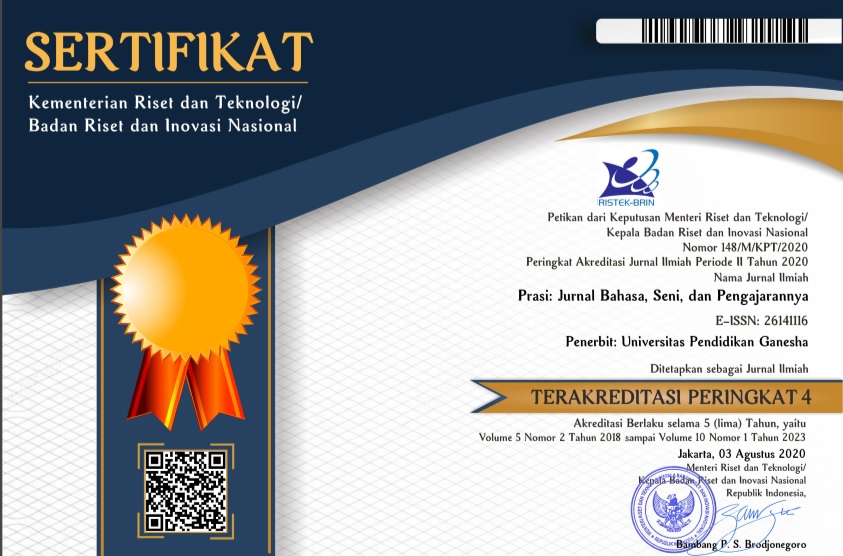THE LEXICONS AND FORMATION FOUND IN TRUNAJAYA DANCE
DOI:
https://doi.org/10.23887/prasi.v18i01.53867Keywords:
Formation, lexicons, Trunajaya DanceAbstract
Balinese language is regarded as the reflection of Balinese culture in which preserving Balinese language is also a way for preserving Balinese culture. It can be seen through the use of Balinese language in Balinese dance which is Trunajaya dance. This study aimed at finding the lexicons and the formation found in Trunajaya dance. The method of this study was qualitative study by adapting ethnography model. The setting of this study was Jagaraga village. The data were collected by conducting interview and observation where three dancers were selected as the informants of this study. The instruments used were interview guide and observation sheet. Interview guide was used for collecting the data about lexicons used and the meanings of those lexicons. Observation sheet was used to collect the lexicons used for every part of the dance. The collected data were analyzed by using Qualitative Data Analysis. The results showed that there were 46 lexicons found in the movements and costume were wore by the Trunajaya dancers. It was also found out that the word-formations of the lexicons were affixation, reduplication, and compound.
References
Adha, A. D., & Dania, R. (2020). Morphological Analysis of Word Formation Found in VOA News Articles. IDEAS: Journal on English Language Teaching and Learning, Linguistics and Literature, 8(2), 458–470. https://doi.org/10.24256/ideas.v8i2.1613
Budasi, I. G., Satyawati, M. S., & Anggayana, W. A. (2021). The status of lexicon used in tabuh rah ritual in menyali village north bali: An ethnolinguistic study. Kasetsart Journal of Social Sciences, 42(4), 960–967. https://doi.org/10.34044/j.kjss.2021.42.4.33
Budasi, I. G., & Suryasa, I. W. (2021). The cultural view of North Bali community towards Ngidih marriage reflected from its lexicons. Journal of Language and Linguistic Studies, 17(3), 1484–1497. https://doi.org/10.52462/jlls.107
Dewi, A. A. I. M. D., Budasi, I. G., & Suarnajaya, I. W. (2020). Lexicons in Legong Keraton dance. LINGUA SCIENTA: Journal of Foreign Language Teaching and Linguistics, 27(2).
Habtoor, H. A. (2002). Language maintenance and language shift among second generation Tigrinya-Speaking Eritrean immigrants in Saudi Arabia. Theory and Practice in Language Studies, 2(5), 945–955.
Miles, M. B., & Huberman, A. M. (1994). Qualitative Data Analysis. Sage Publication.
Rasmi, R., Garap, K., & Pembelajarannya, D. A. N. (2015). Tari Oleg Tamulilingan Gaya Peliatan Karya I Gusti Ayu Raka Rasmi: Kreativitas Garap Dan Pembelajarannya. Catharsis, 4(2), 76–82.
Sinaga, Y. K., Herman, H., & Tannuary, A. (2022). Discovering the Pattern of Pop Song Artist’s Word Formation Processes for Slangs. Elsya : Journal of English Language Studies, 4(2), 157–167. https://doi.org/10.31849/elsya.v4i2.6337
Sirbu, A. (2015). The significant of language as a tool of communication. PROQUEST SciTech Journals, 18(2), 405–406. https://doi.org/10.21279/1454-864X
Solgi, F., & Tafazoli, D. (2018). The necessity of teaching culture in English as a foreign language course: Iranian perspective Farzaneh. Journal of Language and Linguistic Studies, 14(3), 1–11. https://www.jlls.org/index.php/jlls/article/view/691
Stuti, N. N. W., Ramendra, D. P., & Utami, I. A. M. I. (2018). the Jargons Used By Balinese Dancer of Female At Sanggar Seni Manik Uttara. Language and Education Journal Undiksha, 1(1), 41–52. https://doi.org/10.23887/leju.v1i1.20251
Sustiawati, N. L., Arini, A. A. A. K., Suci, N. N., Armini, N. L., & Sukasih, N. N. (2011). Pengetahuan Seni Tari Bali. PT. Empat Warna Komunikasi.
Widarta Kusuma, I. M. A., Budasi, I. G., & Suarnajaya, I. W. (2020). Lexicons of Tabuh Rah Used in Menyali Village. Prasi, 15(02), 71. https://doi.org/10.23887/prasi.v15i02.26906
Yulianti, N. K. D., Widyarto, R., & Yuliasih, N. K. (2014). Eksistensi Tari Bali dan Jawa Dalam Bahasa Indonesia dan Inggris. Jurnal “Segara Widya,” 2(1), 249–259.
Downloads
Published
Issue
Section
License
Copyright (c) 2023 Dharma Susena Suyasa Made, Suta Paramarta I Made , Budasi I Gede

This work is licensed under a Creative Commons Attribution-NonCommercial-ShareAlike 4.0 International License.
Authors who publish with Prasi agree to the following terms:- Authors retain copyright and grant the journal the right of first publication with the work simultaneously licensed under a Creative Commons Attribution License (CC BY-SA 4.0) that allows others to share the work with an acknowledgment of the work's authorship and initial publication in this journal
- Authors are able to enter into separate, additional contractual arrangements for the non-exclusive distribution of the journal's published version of the work (e.g., post it to an institutional repository or publish it in a book), with an acknowledgment of its initial publication in this journal.
- Authors are permitted and encouraged to post their work online (e.g., in institutional repositories or on their website) prior to and during the submission process, as it can lead to productive exchanges, as well as earlier and greater citation of published work. (See The Effect of Open Access)


.png)
.png)









